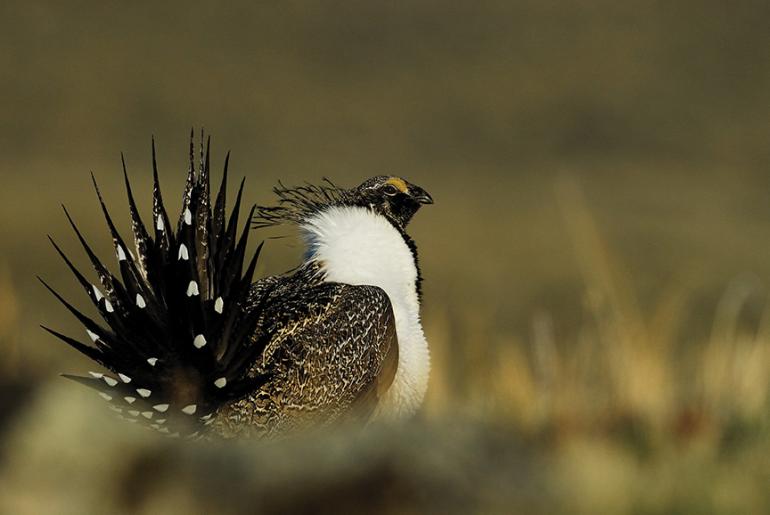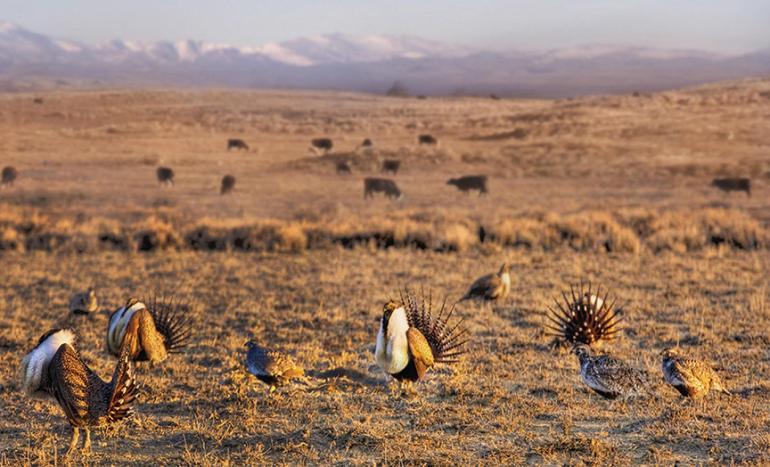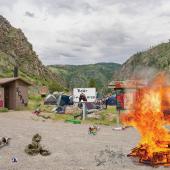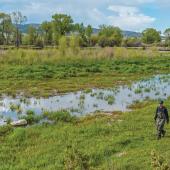Saving Sage Grouse
Conserving Montana's largest game bird.
Stamping my feet on the frozen ground, I waited impatiently for an elusive football-sized bird to appear in the murky pre-dawn light. A spotting scope stood at the ready, my tool to count sage grouse during their annual quirky courtship dance.
I wasn't freezing my butt off just to giggle at some horny birds. Each spring, volunteers and biologists set up scopes across Montana to gather data on how sage grouse are faring. The observations from this particular mating site (known as a lek) near Dillon would merge with those from hundreds of leks statewide. This population data helps Montana Fish, Wildlife & Parks (FWP) decide whether sage-grouse hunting is allowed in the coming fall.
As the sun lightened the landscape, my scope filled with strutting grouse and my frozen feet were quickly forgotten. Males ran around like cartoon characters, their spiky tails fanned high as yellow air sacs inflated on bright-white chests. Funny critters, made funnier by the fact that the boring-looking hens couldn’t care less about the males’ elaborate display. My final count: 23. Not bad for a bird that's disappearing from many parts of the West.
A Dwindling Resource
The largest grouse in North America, the greater sage grouse is also the most threatened. These birds rely entirely on sagebrush for food, shelter, and survival. Unfortunately, the once-vast sagebrush sea is now chopped up by human-generated intrusions. Sage grouse have dwindled to ten percent of their historic numbers due to habitat loss. This decline led to petitions requesting that the U.S. Fish and Wildlife Service list the bird under the Endangered Species Act. Many westerners are waiting with bated breath for this fall’s decision on whether to list the sage grouse. The threat of listing has spurred impressive proactive conservation efforts among unlikely partners who are concerned that a listing would disrupt economic mainstays. Since 2010, the NRCS-led Sage Grouse Initiative has enrolled more than 1,100 ranchers in 11 states to voluntarily conserve habitat on 4.4 million acres of working lands—an area twice the size of Yellowstone National Park. The partnership has invested more than $424 million to date, and pledged to continue investing in sage grouse conservation projects through 2018.
Montana Leads the Way
“Montana is home to one of the largest populations in the western states, and has some of the most habitat,” says Catherine Wightman, sage grouse habitat coordinator with FWP. “I’m hopeful that the state can step up to meet the conservation challenge.”
The main threat to species recovery in Montana is converting native sagebrush into cropland. Oil and gas development, subdivisions, roads, pipelines, power lines, and even cell towers also nibble into the dwindling habitat that sustains this imperiled bird.
The state legislature passed the Sage Grouse Stewardship Act this past spring, which includes regulatory components to limit activities that threaten the bird’s recovery, as well as a $10 million stewardship fund to conserve core habitat. This summer, Governor Bullock ramped up the state’s commitment by signing a landmark agreement with the NRCS to enhance voluntary approaches for protecting the species.
A Beacon of Hope
Southwest Montana is one of the few areas west-wide where sage grouse are faring well, due to large expanses of intact, good-quality sagebrush habitat. The population has remained stable enough to allow continued hunting of this popular upland game species. The rest of Montana can’t say the same. Last year, FWP put in place the first-ever season closure for sage grouse. During the spring 2014 lek counts, numbers came up short. So short, in fact, that FWP halted hunting in many eastern counties, and shortened the season in the open areas to just 30 days. Concerned by the first-ever hunting closure, sportsmen groups came out in support of the Sage Grouse Stewardship Act. “This is a bird that inhabits some of the most beautiful spots in Montana,” says Dan Bailey, Montana regional representative for Pheasants Forever. “It’s our responsibility as sportsmen to do what we can to protect it.”
This year’s strong showing at sage grouse leks—like the one I surveyed near Dillon—offers a ray of hope. FWP documented a 75 percent increase in sage grouse numbers from 2014 to 2015. If the population upswing continues, this iconic bird will dance through Montana sunrises long into the future.
Brianna Randall is a freelance writer and communications specialist for several businesses and nonprofits, including the NRCS-led Sage Grouse Initiative.














